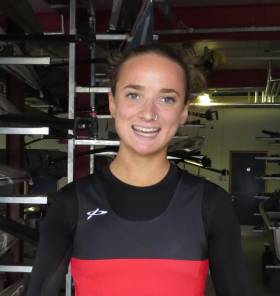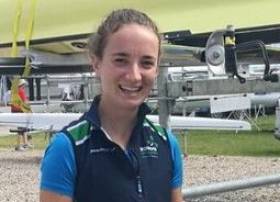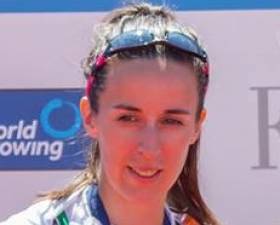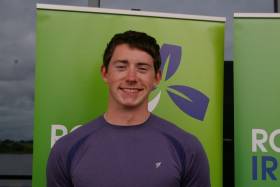Displaying items by tag: Margaret Cremen
Cremen and Dorney Top Rankings on Cork Sculling Ladder
#Rowing: Jack Dorney of Shandon and Margaret Cremen of Lee were the overall winners of the Cork Sculling Ladder. The presentations will take place this Thursday (January 31st) at Cork Boat Club. The Ladder is sponsored by Argos Fire.
Cork Sculling Ladder - Overall Winner : (1) Jack Dorney - Shandon Boat Club.
Women’s Overall Winner: (13) Margaret Cremen - Lee Rowing Club (retained)
Section Winners
Men
Jack Dorney - Shandon Boat Club, Open, Intermediate, Club 1, Club 2, Junior 18 and Junior 16
Jack Kiely - Lee Rowing Club, Novice
Peter Leonard - Cork Boat Club, Junior 15 and Junior 14
David Ross – Chu - Shandon Boat Club, Junior 13
Cian Dunlop - Lee Rowing Club, Junior 12
Donal Smith - Shandon Boat Club, Masters A & B
Henrik Merz - Shandon Boat Club, Masters C
John O’Neill - Shandon Boat Club, Masters D
Tony Corcoran - Lee Valley Rowing Club, Masters E, F, G & H
Women
Margaret Cremen - Lee Rowing Club, Open, Intermediate and Junior 18
Aoife Lynch - Lee Rowing Club, Club 1, Junior 16 and Junior 15
Claragh O’Sullivan - Cork Boat Club, Club 2
Maeve Coakley - Lee Rowing Club, Novice
Jennifer Forde - Shandon Boat Club, Junior 14
Isobel McElwain - Lee Rowing Club, Junior 13
Emer Hannon - Lee Rowing Club, Junior 12
Jessica Legresly - Shandon Boat Club, Masters A & B
Vivian Kelleher - Lee Rowing Club, Masters C
Liz Buckley - Lee Rowing Club, Masters D
O'Donovans and Puspure Add Lustre as McCarthy and Cremen Start Season with Wins [UPDATE]
#Rowing: A big and enthusiastic crowd greeted rowers from the Ireland World Championships team at the National Rowing Centre today. Aifric Keogh and Emily Hegarty, who reached the final of the women’s pair, joined gold medallists Sanita Puspure, Paul O’Donovan and Gary O’Donovan.
The Minister of State with responsibility for Sport, Brendan Griffin, told the rowers and the crowd that he was fighting for funding at cabinet level, while the Cork County Mayor, Patrick Gerard Murphy, made an eloquent speech about how the present team inspire others.
Outside, the All Ireland Youth and Irish Open Regatta reflected the enthusiasm and ambition of the contenders for top spots. Lee woman Margaret Cremen was a convincing winner of the single sculls, while Fintan McCarthy – who was exempt, as he had competed at the World Championships – went ahead and won the men’s single.
Earlier Jack Dorney of Shandon and Aoife Lynch of Lee won the junior singles.
Irish Open Regatta, National Rowing Centre, Cork, September 29th
Men
Four: UCD (senior). Under-23: Coláiste Iognáid (jun).
Pair: NUIG (D Buckley, E Whittle; sen). Under-23: UCD. Jun: Commercial.
Sculling
Double: St Michael’s/UCC (sen). Under-23: Three Castles (jun)
Single: Skibbereen (F McCarthy; sen). Under-23: Queen’s (M Taylor). Jun: Enniskillen (O Donaghy)
Women
Four: Colaiste Iognaid A (jun)
Pair: UCC/Skibbereen (T Hanlon, N Casey; sen). U-23: Bann/Neptune. Jun: St Michael’s A.
Sculling
Double: Neptune/Bann (sen). U-23: Killorglin (jun).
Single: UCC (M Cremen, Under-23). NUIG (O’Connor; first senior). Jun: Lee (A Lynch).
Youth Regatta (Selected)
Men
Sculling, Quadruple, Junior 16, coxed: St Michael’s. Single, Jun 16: Kenmare (Kelly)
Women
Sculling, Quadruple, Junior 16, coxed: St Michael’s. Single, Jun 16: Lee Valley (Davis)
#Rowing: Jake and Fintan McCarthy raced brilliantly to win their heat and qualify directly for the A/B Semi-Finals at the World Under-23 Rowing Championships in Poland this morning. There was just one direct qualification place on offer in this heat of the lightweight double sculls and Italy gave Ireland quite a race. The two crews were locked together as they approached the 1500-metre mark – but then the McCarthy twins went. They led by .18 of a second at 1500 metres and sprinted away from their rivals to win well.
Lydia Heaphy and Margaret Cremen made a solid start to their campaign in the women’s lightweight double by taking the second and final qualification spot in their heat. They were fastest to the 500 metre mark, but Britain’s Susannah Duncan and Danielle Semple took over from there. They would build their lead to win by almost eight seconds. Cremen and Heaphy secured their spot, staying well clear of third-placed Poland.
World Under-23 Championships, Poznan, Poland (Irish interest; selected results)
Men
Lightweight Double Sculls – Heat Three (First to A/B Semi-Finals; rest to Repechage): 1 Ireland (F McCarthy, J McCarthy) 6:35.94.
Women
Lightweight Double Sculls – Heat Four (First Two to A/B Semi-Finals; rest to Repechage): 2 Ireland (L Heaphy, M Cremen) 7:37.99.
O'Donovans Tested by Skibbereen Twins at Cork Regatta
#Rowing: Paul O’Donovan and Gary O’Donovan were tested in the men’s double sculls by Jake and Fintan McCarthy at Cork Regatta today. The two Skibbereen crews fought it out down the course with the twins not letting the O’Donovan brothers build a clear-water lead. At the end the McCarthy’s pushed, and there was less than a length in it.
UCD’s four were impressive winners. The crew of Shane O’Connell, Andrew Goff, Shane Mulvaney and David O’Malley left Commercial behind.
The Skibbereen/Lee combination of Denise Walsh and Margaret Cremen were also in charge in the women’s double. Behind them the junior double from Workmen’s won a battle for second.
Cork Regatta, Day Two (Selected Results)
Men
Four – Div One: 1 UCD (S O’Connell, A Goff, S Mulvaney, D O’Malley; sen) 6:33.45, 2 Commercial (sen) 6:38.28, 3 Shandon (sen) 6:46.05. Four, coxed – Div Two: 1 UCC (club two) 7:00.73; 6 St Joseph’s 7:19.29. C Final: 3 St Michael’s (jun 16) 7:40.34.
Sculling, Double – Div One: 1 Skibbereen A (G O’Donovan, P O’Donovan; sen) 6:46.14, 2 Skibbereen B (sen) 6:47.68; 4 Queen’s (inter) 7:15.57. B Final: Castleconnell (jun 18A) 7:19.86. C Final: 5 Belfast RC (club one) 7:57.44.
Single – Div Two: 1 Kenmare (T Kelly; jun 16) 8:01.71, 2 New Ross (jun 18B) 8:03.67, 3 Workmen’s (club two) 8:04.995.
Women
Sculling, Double – Div One: 1 Skibbereen, Lee (M Cremen, D Walsh; sen) 7:42.97, 2 Workmen’s (jun 18A) 7:56.34, 3 Fermoy (inter) 7:57.45. B Final: 4 Fermoy Castleconnell (club one) 8:17.57.
#Rowing: Margaret Cremen and Denise Walsh qualified for the A/B semi-finals at the World Cup regatta in Belgrade today. The Lee/Skibbereen combination took third place in their repechage. Poland and the Netherlands fought for the lead, with the Dutch coming out on top. Walsh and Cremen comfortably held off Austria and China Two, who drop into the C Final.
World Cup Regatta, Belgrade (Irish interest)
Men
Pair – Heat Four (Winner to A/B Semi-Finals; rest to repechage): 1 Czech Republic 6:41.22; 2 Spain 6:48.03, 3 China One 6:51.79, 4 Ireland (M O’Donovan, S O’Driscoll) 6:51.91. Repechage Three (First Two to A/B Semi-Finals; third to C Final; rest to C or D Final): 1 Netherlands One 6:48.68, 2 Netherlands Two 6:50.07; 3 Ireland 6:51.82.
Lightweight Double Sculls – Heat Three (First two to A/B Semi-Finals; rest to repechage): 1 Canada Two 6:32.69, 2 Ireland (G O’Donovan, P O’Donovan) 6:34.29.
Women
Pair – Heat One (First Three to A/B Semi-Finals; rest to repechage): 1 Britain One 7:19.05, 2 Britain Two 7:22.92, 3 Ireland (A Keogh, E Hegarty) 7:23.77.
Double Sculls – Heat Three (First Three to A/B Semi-Finals; rest to repechage): 1 Netherlands 7:10.90, 2 China One 7:16.89, 3 Ireland (A Crowley, M Dukarska) 7:20.40.
Lightweight Double Sculls – Heat One (First two to A/B Semi-Finals; rest to repechage): 1 Britain One 7:26.96, 2 United States One 7:28.40; 5 Ireland (M Cremen, D Walsh) 7:50.34. Repechage Two (First Three to A/B Semi-Finals; rest to C Final): 1 Netherlands 7:24.73, 2 Poland 7:25.79, 3 Ireland 7:30.46.
Single Sculls – Heat One (First Two to A/B Semi-Finals; rest to repechage): 1 Ireland (S Puspure) 7:50.48, 2 Ukraine (D Dymchenko) 7:59.30.
Walsh and Cremen Set for Repechage at World Cup
#Rowing: Denise Walsh and Margaret Cremen finished fifth in their heat of the lightweight double sculls at the World Cup Regatta in Belgrade and must compete in a repechage as they seek a semi-final place. There were just two places on offer in the heat and Britain One and the United States One asserted control early on and took them in that order. Ireland found themselves behind four crews from early on in the race and the order did not change.
World Cup Regatta, Belgrade (Irish interest)
Men
Pair – Heat Four (Winner to A/B Semi-Finals; rest to repechage): 1 Czech Republic 6:41.22; 2 Spain 6:48.03, 3 China One 6:51.79, 4 Ireland (M O’Donovan, S O’Driscoll) 6:51.91.
Women
Pair – Heat One (First Three to A/B Semi-Finals; rest to repechage): 1 Britain One 7:19.05, 2 Britain Two 7:22.92, 3 Ireland (A Keogh, E Hegarty) 7:23.77.
Double Sculls – Heat Three (First Three to A/B Semi-Finals; rest to repechage): 1 Netherlands 7:10.90, 2 China One 7:16.89, 3 Ireland (A Crowley, M Dukarska) 7:20.40.
Lightweight Double Sculls – Heat One (First two to A/B Semi-Finals; rest to repechage): 1 Britain One 7:26.96, 2 United States One 7:28.40; 5 Ireland (M Cremen, D Walsh) 7:50.34.
Single Sculls – Heat One (First Two to A/B Semi-Finals; rest to repechage): 1 Ireland (S Puspure) 7:50.48, 2 Ukraine (D Dymchenko) 7:59.30.
Hot Competition at Ireland Rowing Trial
#Rowing: The standard was high at the second session of the Ireland Trial at the National Rowing Centre in Cork. Patrick Boomer and Andy Harrington again tested Shane O’Driscoll and Mark O’Donovan in the pair – this time the margin was just 1.3 seconds – and Sanita Puspure came in under seven minutes 40 seconds in another outstanding performance in the single sculls.
There was an all-Skibbereen shootout in the lightweight doubles: twins Jake and Fintan McCarthy, who are just 21, came in just 2.8 seconds behind Paul and Gary O’Donovan.
Margaret Cremen teamed up with Denise Walsh to produce a fast lightweight double, while Monika Dukarsa and Aileen Crowley formed a heavyweight double which also produced a good performance. Aifric Keogh and Emily Hegarty formed a pair which also bettered 90 per cent of projected world best time.
A second configuration of the men’s junior quad did very well, while the women’s junior double from Workmen’s again produced one of the best performances of the day.
Byrne Best Again in Cork Sculling Time Trial
#Rowing: Ronan Byrne came home fastest of over 200 scullers to win the Cork Sculling Ladder time trial at the Marina in Cork. The UCC man, the outright sculling ladder winner for the two seasons and time trial winner 12 months ago, won in a time of seven minutes 12 seconds from Dan Begley of Shandon, and joint-third placed Stephen O’Sullivan (Shandon) and Barry O’Flynn (Cork BC).
Margaret Cremen of Lee Rowing Club – also the ladder winner last season – won the women’s section. She recorded a time of eight minutes and .8 of a second. Aoife Lynch (Lee) was second and Elma Bouanane of Fermoy third.
The ladder continues until the April 2nd, 2017.
Cork Sculling Ladder 2016 Time Trial: Results
Men
1 Ronan Byrne, UCC. 7: 12.00
2 Dan Begley, Shandon BC. 7: 14.7
3= Stephen O’Sullivan, Shandon BC. 7: 23.6
3= Barry O’Flynn, Cork BC. 7: 23.6
5 Colm Hennessy, Shandon BC. 7: 29.7
6 Jack Casey, Shandon BC. 7: 31.8
7 Andy Harrington, Shandon BC. 7: 33.6
Women
1 Margaret Cremen, Lee RC. 8: 00.8
2 Aoife Lynch, Lee RC. 8: 31.3
3 Selma Bouanane, Fermoy RC. 8: 32.5
4 Aoife Higgins, Cork BC. 8: 43.4
5 Clara O’Sullivan, Cork BC. 8: 44.1
Silver and Bronze for Ireland Rowers at Coupe de la Jeunesse
#Rowing: Ireland took two medals on the second day of the Coupe de la Jeunesse in Poznan, Poland today. The Ireland pair of Tara Hanlon and Amy Mason rowed to a fine second place behind Britain, putting pressure on the long-time leaders coming up to the line. The junior quadruple of Lucy Taylor, Hannah Scott, Fiona Chestnutt and Margaret Cremen took bronze in their final. They were fourth until halfway, but put in a fine second 1,000 metres, taking over a clear third as Italy faded back. Switzerland took gold ahead of Britain.
The junior men’s four finished second in their B Final, and the junior men’s quad were 4th in theirs, one place ahead of the Netherlands.
Coupe de la Jeunesse, Poznan, Poland (Irish interest; selected results)
Day Two
Men
Junior Four - Heat One (First Three to A Final; rest to B Final): 4 Ireland 6:51.55. B Final: 2 Ireland 6:52.17.
Junior Quadruple: Heat Two (First Three to A Final; rest to B Final): 5 Ireland 6:38.47. B Final: 4 Ireland 6:35.36.
Women
Junior Pair (First Three to A Final): 1 Britain 8:03.61, 2 Ireland 8:07.85. A Final: 1 Britain 7:41.82, 2 Ireland 7:43.34, 3 Belgium 7:48.62.
Junior Quadruple (First Three to A Final; rest to B Final): 1 Ireland 7:07.21. A Final: 1 Swit 6:54.88, 2 Britain 6:56.01, 3 Ireland 6:58.11.
































































